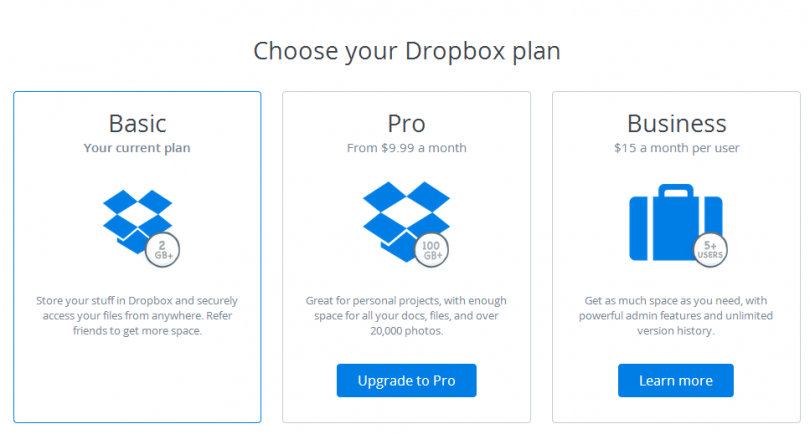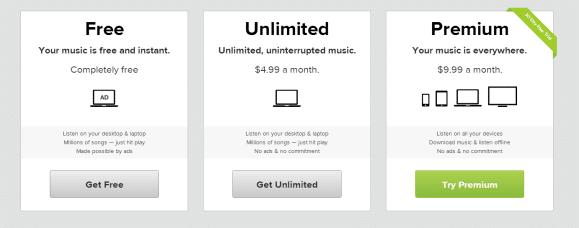Freemium is a business model where a firm gives away its product for free with the aim of later converting some users to the paid version. Freemium is different to a trial offer because the user can continue to use the free version for a prolonged period. Freemium is like an indefinite free trial. Dropbox is an example of a company that can give a very good free service. But if people become big users there is a strong incentive to upgrade to more disc-space.
Dropbox is an example of a company that can give a very good free service. But if people become big users there is a strong incentive to upgrade to more disc-space.
Origins of Freemium
Although freemium models have been in use for many years, it has become a very popular model for internet firms, who can expand usage with a very low marginal cost. The concept was coined by Fred Wilson a Silicon Valley business investor in a 2006 blog post. He defined the freemium model as
“Give your service away for free, possibly ad supported but maybe not, acquire a lot of customers very efficiently through word of mouth, referral networks, organic search marketing, etc, then offer premium priced value added services or an enhanced version of your service to your customer base.” AVC.com
Examples of successful companies using premium as basis
- Zoom – free video calls up to 45 minutes. Paid version for longer calls.
- Skype – free video/audio calls with premium services for calling phone numbers.
- Dropbox – Free storage up to 2GB, but then paying for extra storage.
- Strava – free to users to log cycle-rides/ runs. But premium service – such as training zones, power output and training feedback.
- WordPress plugins – Most plugins I use for WordPress come for free, but there also exists premium versions.
- Video games like Fortnite. WHere basic game is free, but users can pay for premium passes
Spotify options – free and premium options
Types of Freemium
- Ad-free versions. Many newspapers are willing to offer free online articles because they can gain some revenue from advertising. Newspapers may insist on removing ad blockers. The premium version is free of ads. It is a similar case with Spotify with the free version supported by ads.
- More features. The free version has basic functionality but limited features. The paid version can entice customers with extra features (e.g. Zoom longer calls)
- Number of users. Many email senders may give free versions to those with less than 2,000 subscribers, but once number of users exceeds a certain number, charges begin.
- Indirect revenue – Facebook’s basic model is free. They monetise not by offering premium versions to users but by being able to sell advertising to its large captive audience. The great success of Facebook was becoming the dominant social media company, creating a captive market for new users. (there’s no point in being on social media network that your friends are not)
Why Freemium is an attractive business model?
- Market share. Through offering the product for free, the firm aims to gain a large market share and user base, which it can then use to try to upgrade the free users to a premium version of the product at a later date.
- Gain information about potential consumers. Freemium usually involves signing up with email and name. A valuable resource to firms.
- Low marginal cost. Many internet services have low marginal cost. Once you have basic infrastructure and product development, allowing more users only increases total costs in a very limited way. Therefore, firms have little cost from giving away for free.
- Economies of scale. In areas with large economies of scale, it makes sense to try and increase customer base as average costs fall.
- Viral nature of many internet services. A key issue in many uses of technology is compatibility with other users. If your friends are using Strava, it makes Strava an attractive choice over less well-used services. By giving away services for free, it makes it easier for firm to gain viral growth and become a dominant firm in the industry.
- Entice customers. Users may be uncertain how much they will use a service. If there is a cost, that will discourage the customer. By being able to use a free version, they may gain the confidence that they will really value it.
- Price discrimination. Premium models enables firms to discriminate between large users and small users. A minor user will stay on the free version, but big companies which are heavier users will gravitate towards paying for premium versions which is.
- Good business/firm relationships. Firms become rewarded for giving good service so there is a strong incentive to develop good relationship with consumers.
Successful Freemium model
To be successful, a firm needs to create
- A free product that is useful to consumers
- A premium version that gives a strong enough incentive for some free users to upgrade to the paid version
- Keep costs sufficiently low whilst revenue grows.
Disadvantages of Freemium for firms
- Firms may need to make loss for a considerable time. Many business models are based on gaining large user base to be able to convert into paid customers a long time in the future. If the firm doesn’t have sufficient finance it may not be able to afford.
- By the time, the firm may have gained a large user base, the desirability of the premium version may have been lost. For example, a bigger company may come a long and give the premium service for free. For example, a small file storage company may give 2GB free and premium starts at 2GB+, but then dropbox may come along and the free version is up to 2TB. So the business model of the first company is
- Freemium models can be difficult to make profit. If too many customers want to stay on the free version, the revenue may not make up the costs. Spotify may seem to have an enviable market base, but in the decade between 2010 and 2020 it made a loss of €2.62 billion (loss making Spotify)
- Once customers get used to the free model, they may resent any pressure to upgrade
Advantages of Freemium for consumers
- Zero cost
- It allows testing
- Consumers with low income may not be able to pay, but through premium, they get the basic functionality.
- Consumers may be just as happy with the simple free version as more complex premium
- It encourages a different mindset to usual marketplace deals. With usual services you pay before you get to use the good and service. With freemium, you pay after using for a considerable time. Some consumers may view upgrading to premium model – like giving a waiter a tip
Disadvantages of Freemium for consumers
- Bait and switch. Some firms may use the premium model to increasingly pressure consumers to switch to paid-for version. When you get using to a certain software you may feel you have no choice but to go to the premium version (e.g. firm could make free version slower)
- With strong market share, firm can start to increase price for its premium version (e.g. Spotify)
Economic concepts behind Freemium
- Marginal cost – The cost of adding extra users must be low.
- Economies of scale – Higher output leads to declining average costs and makes premium more likely.
- Market share -Gaining market share and monopoly power enable higher prices in long term.
- Gift Giving – If consumers are very happy with the free model and they feel the firm has given them a good service, then they may feel inclined to reciprocate the goodwill and adopt the premium version – even though strictly they don’t need it.

